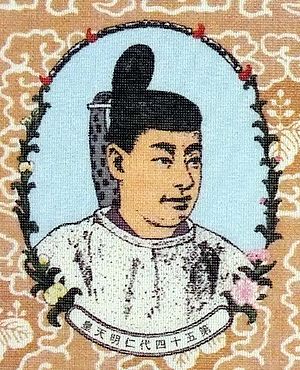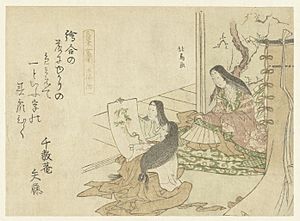Emperor Ninmyō facts for kids
Quick facts for kids Emperor Ninmyō仁明天皇 |
|||||
|---|---|---|---|---|---|
 |
|||||
| Emperor of Japan | |||||
| Reign | 22 March 833 – 4 May 850 | ||||
| Enthronement | 30 March 833 | ||||
| Predecessor | Junna | ||||
| Successor | Montoku | ||||
| Born | Masara (正良) 27 September 808 |
||||
| Died | 6 May 850 (aged 41) Heian Kyō (Kyōto) |
||||
| Burial | Fukakusa no misasagi (深草陵) (Kyoto) | ||||
| Issue more... |
|||||
|
|||||
| House | Yamato | ||||
| Father | Emperor Saga | ||||
| Mother | Tachibana no Kachiko | ||||
Emperor Ninmyō (仁明天皇, Ninmyō-tennō, 27 September 808 – 6 May 850) was the 54th emperor of Japan. He ruled from 833 to 850, during a time in Japanese history called the Heian period.
Contents
Who Was Emperor Ninmyō?
Emperor Ninmyō was the second son of Emperor Saga and Empress Tachibana no Kachiko. His birth name was Masara (正良). After he passed away, he was given the special title of Ninmyō (仁明).
Emperor Ninmyō had many family members. He had nine empresses, imperial consorts, and concubines. He also had 24 imperial sons and daughters.
His tomb is a special place called the Fukakusa no Misasagi (深草陵, Fukakusa Imperial Mausoleum). It is located in Fushimi-ku, Kyoto. This is where people traditionally honor him.
Important Events During His Rule
Ninmyō became emperor after his uncle, Emperor Junna, stepped down from the throne.
- January 6, 823: At the age of 14, Prince Masara was given the important title of Crown Prince. This meant he was next in line to become emperor.
- March 22, 833: Emperor Junna decided to step down. His adopted son, Prince Masara, became the new emperor. Prince Masara was actually Emperor Saga's son and Emperor Junna's nephew. Soon after, he officially became Emperor Ninmyō.
After becoming emperor, Ninmyō chose an heir. He named Prince Tsunesada, who was a son of the previous Emperor Junna, as the new Crown Prince.
- 835: A famous monk named Kūkai passed away. He was also known as Kōbō-Daishi. Kūkai was a scholar, poet, and artist. He founded an important Buddhist school called Shingon.
- 838-839: A group of Japanese diplomats traveled to Tang China. This mission was led by Fujiwara no Tsunetsugu.
- 842: A big political event happened called the Jōwa Incident. Because of this, Prince Tsunesada was no longer the Crown Prince. Instead, Ninmyō's first son, Prince Michiyasu, became the new Crown Prince. Prince Michiyasu later became Emperor Montoku. His mother was Empress Fujiwara no Junshi. This change was likely due to political plans by Ninmyō and Fujiwara no Yoshifusa. Yoshifusa was a powerful figure who would later become a regent. He had many family connections to the imperial court.
Emperor Ninmyō could not have known that his third son, Prince Tokiyasu, would also become emperor much later in 884. Prince Tokiyasu became Emperor Kōkō.
- May 6, 850: Emperor Ninmyō passed away when he was 41 years old. He was sometimes called "the Emperor of Fukakusa" because that was the name of his tomb.
Eras During Ninmyō's Reign
The years of Emperor Ninmyō's rule are known by different era names (nengō). These eras help historians keep track of time.
Important Court Officials
The Kugyō (error: {{nihongo}}: Japanese or romaji text required (help)) was a special group of very powerful men. They worked closely with the Emperor of Japan before the Meiji period.
This group usually had only three or four men at a time. They were from important families and had a lot of experience. During Emperor Ninmyō's reign, some of these top officials included:
- Sadaijin (Minister of the Left): Fujiwara no Otsugu and Minamoto no Tokiwa.
- Udaijin (Minister of the Right): Kiyohara no Natsuno, Fujiwara no Mimori, Minamoto no Tokiwa, Tachibana no Ujikimi, and Fujiwara no Yoshifusa.
- Naidaijin (Minister of the Center): This position was not filled during his reign.
- Dainagon (Chief Counselor): Fujiwara no Otsugu.
Emperor Ninmyō's Family
Emperor Ninmyō had many consorts and children. Here are some of them:
Empresses and Consorts
- Empress Dowager Fujiwara no Junshi (809–871): She was the daughter of Fujiwara no Fuyutsugu.
- Their first son was Imperial Prince Michiyasu, who later became Emperor Montoku.
- Consort Fujiwara no Takushi/Sawako (died 839): She was the daughter of Fujiwara no Fusatsugu.
- Their second son was Imperial Prince Muneyasu (828–868).
- Their third son was Imperial Prince Tokiyasu, who later became Emperor Kōkō.
- Their fourth son was Imperial Prince Saneyasu (831–872).
- They also had Imperial Princess Shinshi (died 897).
- Consort Fujiwara no Teishi/Sadako (died 864): She was the daughter of Fujiwara no Tadamori.
- Their eighth son was Imperial Prince Nariyasu (836–853).
- They also had Imperial Princess Shinshi (died 851) and Imperial Princess Heishi (died 877).
- Court Lady Shigeno no Tsunako: She was the daughter of Shigeno no Sadanushi.
- Their fifth son was Imperial Prince Motoyasu (died 902).
- Their ninth daughter was Imperial Princess Tokiko (died 847). She was the second Saiin at Kamo Shrine from 831 to 833.
- They also had Imperial Princess Jūshi (died 869).
- Consort Tachibana no Kageko (died 864): She was the daughter of Tachibana no Ujikimi.
- Consort Fujiwara Musuko
- Court Attendant Ki no Taneko (died 869): She was the daughter of Ki no Natora.
- Their seventh son was Imperial Prince Tsuneyasu (died 869).
- They also had Imperial Princess Shinshi/Saneko (died 870).
- Court Attendant Mikuni-machi (deposed in 845): She was a daughter of the Mikuni clan.
- Their son was Sada no Noboru. He was given the family name "Sada" by the Emperor in 866.
- Court Lady Fujiwara no Katoko: She was the daughter of Fujiwara no Fukutomaro.
- Their sixth son was Imperial Prince Kuniyasu (died 898).
- Court Lady Fujiwara no Warawako: She was the daughter of Fujiwara no Michitō.
- They had Imperial Princess Shigeko (died 865).
- Court Lady Princess Takamune: She was the daughter of Prince Okaya.
- Their seventh or eighth daughter was Imperial Princess Hisako (died 876). She was the 18th Saiō at Ise Shrine from 833 to 850.
- Court Lady, daughter of Yamaguchi clan
- Their son was Minamoto no Satoru (849–879).
- Nyoju (Court Lady) from Kudaraō Toyofuku's daughter
- Their son was Minamoto no Masaru (831–888), who became Udaijin from 882 to 888.
- Their son was Minamoto no Hikaru (846–913), who became Udaijin from 901 to 913.
- Court Lady Kudara no Yōkyō: She was the daughter of Kudara no Kyōfuku.
- Their twelfth daughter was Imperial Princess Takaiko (died 866). She was the third Saiin at Kamo Shrine from 833 to 850.
- Children from unknown mothers
- Minamoto no Suzushi (835–890), who became Sangi from 882 to 890.
- Minamoto no Itaru.
See also
 In Spanish: Ninmyō Tennō para niños
In Spanish: Ninmyō Tennō para niños
- Emperor Go-Fukakusa, a later emperor named in honor of Emperor Ninmyō
- List of Emperors of Japan
- Shoku Nihon Kōki, a Japanese history book that tells about Emperor Ninmyō's reign.


